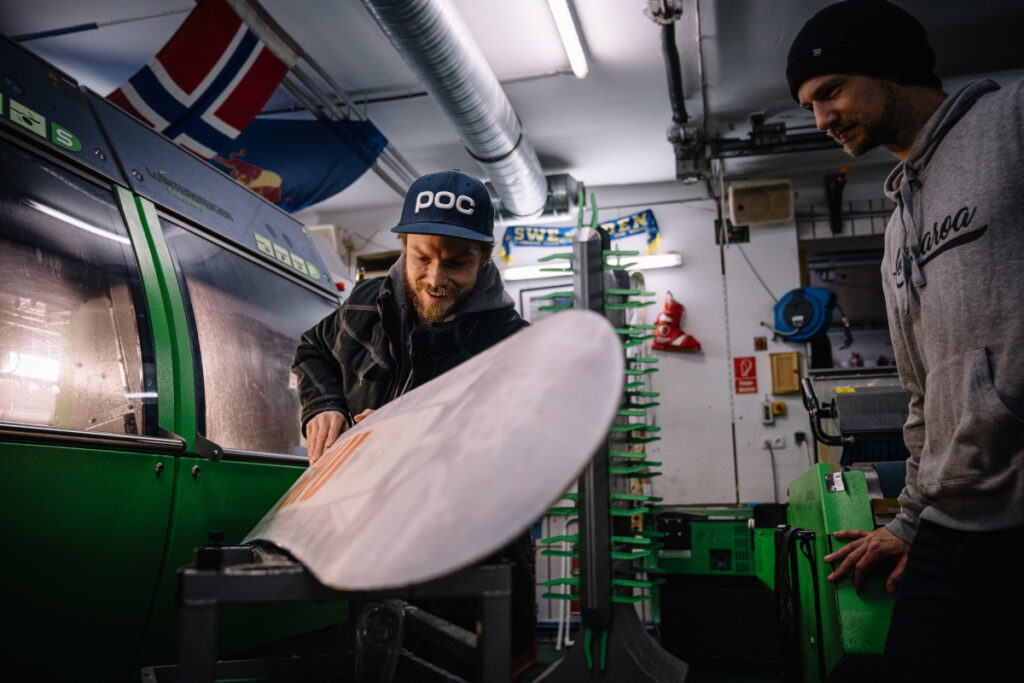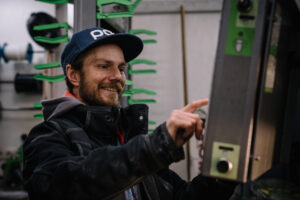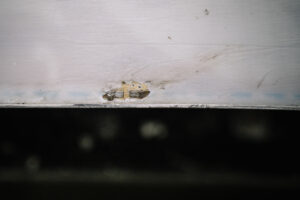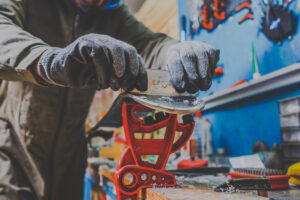
Skiservice / Snowboardservice
There are many thoughts around this topic but think about your equipment as a bike or car, your ride is definitely more enjoyable and safe if your equipment is serviced regularly!
Over time, skis or snowboard can become dull, making it harder to control your movements and increasing the risk of accidents. A well-maintained base helps you glide smoothly, while sharp edges improve grip on icy surfaces. Additionally, applying fresh wax optimizes speed and maneuverability, enhancing your overall skiing/boarding experience. Servicing also extends the lifespan of your skis/snowboard by preventing damage, such as base gouges or rusted edges. In short, servicing is key to performance, safety, and durability throughout the season.
Our recommendation:
- DIY: Waxing and grating of smaller nicks on the edges can be done manually with reasonable tools.
- Professional: Repairs to the base or edge, grinding both edges and the base is better handed over to a professional shop.
TIP: A base grinding is necessary after regular or intensive use to allow the wax to penetrate properly into the base!
Waxing
Waxing your skis or snowboard is crucial for improving performance and ensuring a smooth ride on the slopes. Wax helps reduce friction between the ski base and the snow, allowing for better glide and speed. This not only makes skiing more enjoyable but also helps you conserve energy during long runs. Additionally, wax provides a protective layer to your ski/snowboard base, preventing it from drying out and becoming damaged over time. Regular waxing also enhances your ability to maneuver in varying snow conditions, ensuring optimal control and stability. In short, waxing boosts speed, protection, and overall performance.
The frequency of waxing your skis depends on how often you ski and the conditions you encounter. As a general guideline:
- Frequent skiers (every day or multiple times a week): You should wax your skis every 3-5 days of skiing to maintain optimal performance.
- Casual skiers (a few times a season): Waxing your skis every 5-10 days. Traditionally if you go for a week, you should wax them at the end of the week to protect your base.
- As soon as the base turns greyish or white (from dark black), it is time to wax!
TIP: Harsh conditions: If you ski on icy or abrasive snow, you may need to wax more frequently as the wax wears off faster. In spring, the snow is rougher and the wax will wear of faster.
TIP: End of season: Make sure to wax the base thoroughly! We recommend doing this as part of the end service from a professional shop.
TIP: Hot waxing deeply penetrates the ski base, providing a longer-lasting and more thorough coat compared to rub-on or spray waxes. This ensures smoother gliding, reduces friction with the snow, and optimizes speed. Hot wax also forms a protective layer that shields the ski base from damage, such as drying out, cracking, or collecting dirt. Additionally, hot waxing allows customization based on snow conditions, enhancing performance in specific weather or terrain. Overall, hot waxing ensures better control, durability, and skiing experience.
Edge grinding
Over time, ski edges become dull or damaged from regular use, reducing their ability to grip the snow, especially on icy or hard-packed surfaces. Sharp edges allow for better carving and smoother turns, giving you greater precision and control. Grinding also removes nicks and burrs that can negatively affect performance.
Side edges, can be sharpened with manual tools but it is difficult to maintain the right angle. If you are not experienced this is a tricky task as the effective angle will affect any skier also the beginner! This could have a negative impact on your skiing and learning curve. Grind of grates or burrs is easier and can be done with a soft grindstone.
Base edge, this edge is even trickier to grind with manual tools as you easily affect the base and that will affect the structure and performance negatively. We recommend that you leave your skis to a professional service store.
How often you need to grind the edges depends on how much you ski or snowboard and the conditions you encounter. As a general guideline:
- Frequent skiers (multiple times a week): Grind your edges every 10-15 ski days, especially if you’re skiing on icy or hard-packed snow where sharp edges are crucial.
- Casual skiers: Grinding your edges once or twice a season, particularly before the start of the ski season, can be sufficient.
TIP: After significant damage: If you hit rocks or notice dull or nicked edges, it’s important to grind them immediately. We recommend visiting a professional shop to control if there are further damage to the ski.





Base grinding
Grinding the ski base is important for maintaining smooth, fast, and controlled skiing. Over time, the base of your skis can develop scratches, gouges, and irregularities from regular use or contact with debris on the slopes. These imperfections can slow you down, create drag, and make it harder to glide efficiently. By grinding the base, you restore the structure and flatten the surface, ensuring optimal contact with the snow. This improves glide, enhances speed, and increases maneuverability. Additionally, a fresh grinded base allows wax to adhere better, extending the benefits of waxing.
How often you should grind your ski base depends on your skiing habits and the condition of the base.
As a general guideline: Frequent skiers (multiple times a week):
Base grinding is recomended several times per season, especially if you ski on rough or icy terrain that causes wear.
Casual skiers: Grinding once or twice a season, typically before the start of the season, will keep your skis in good shape.
TIP: After significant damage: If you notice deep scratches, gouges, or an uneven base, it’s important to grind the base immediately to restore performance. We recommend visiting a professional to control if there are further damage to the ski.
TIP: Base grinding applies a structure to the base and needs to be adjusting to cold and warm conditions!
Base repair
A ski base repair means fixing damage to the underside of your skis, typically scratches, gouges, or deep cuts from rocks (shark-bites), debris, or general wear. A common method of repair is filling the damaged areas with a material called P-Tex, which is melted and applied to the base. After the repair material is applied, the base has to be smoothed and leveled through scraping or grinding to ensure a flat surface. Applying P-tex can be done manually and many try it themselves but careful, there can be further damage to the base and what is more important the new material has to be levelled with the base and this requires professional tools.
How often you should repair your ski base depends on your skiing habits and the condition of the base.
As a general guideline:
- All skiers: Larger scratches, many smaller scratches and shark-bites calls for a repair. Damages to the base could allow humidity from the snow to penetrate the lower layers and create serious damage to your ski or snowboard.
TIP: For repairs turn to a professional shop and include the skiservice with base-, edge-grinding and waxing. This will effectively extend the life of your ski/board.
Enjoy the winter!
